Are audiences tiring of 3D movies?
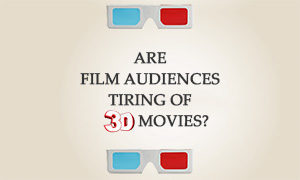
Last week saw the release of Justice League, a film in which a brave, plucky band of CGI artists gallantly battle Henry Cavill's moustache. The film is available to watch in either 2D or 3D, with most multiplexes offering audiences either option. I opted to see it in 2D and very much regretted it (not the choice of 2D, the decision to see it at all).
I had a lot of time to think during the movie, so I started to wonder whether many other film fans would have made the same choice I did and picked the 2D version over the extra-dimensional 3D option.
Sadly the box office figures for Justice League 2D vs Justice League 3D are unlikely to be released so I decided to look at the historic trend more broadly.
The rise of 3D movies
3D movies are about as old as the film business itself. The Lumiere brothers were experimenting with 3D in the early 1900s, and there has been a boom in 3D movies about every thirty years: in the 1920, 1950s, 1980s and most recently in the 2010s.
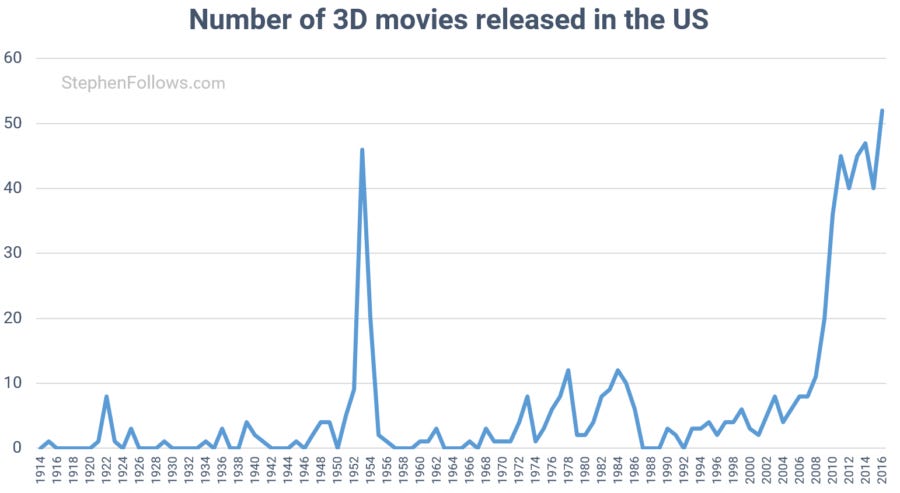
This article focuses on the most recent boom of 3D movies, largely brought about by the advantages of digital cinema and the success of Avatar in 2009. If we focus on this period, we can see a significant rise in 3D releases over the past decade.
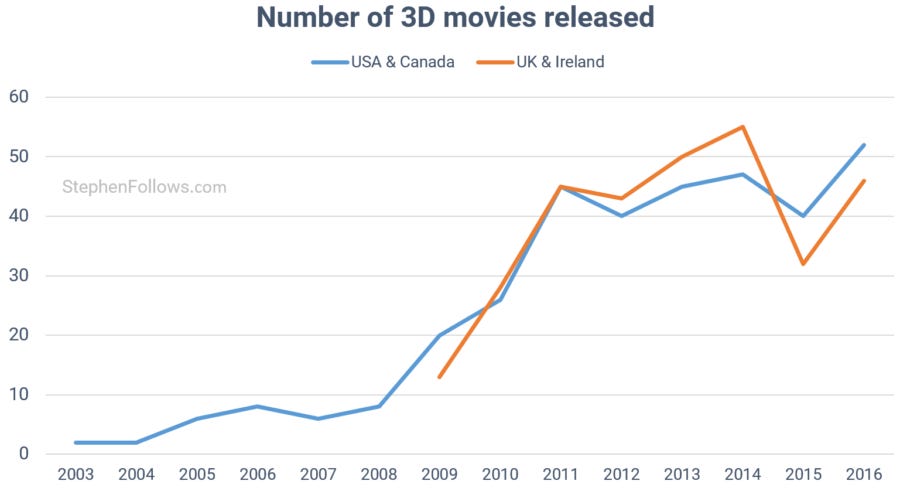
The chart above implies that cinema audiences are becoming ever more enamoured with 3D movies. However, the truth is somewhat more complicated.
What do audiences think of 3D movies?
A 2011 YouGov survey of almost 3,000 Britons gives us an insight into the views of UK cinema-goers. Only 22% thought that watching a movie in 3D improved the overall cinema experience. A whopping 59% either didn't know or didn't care about 3D in the context of their overall cinema experience.
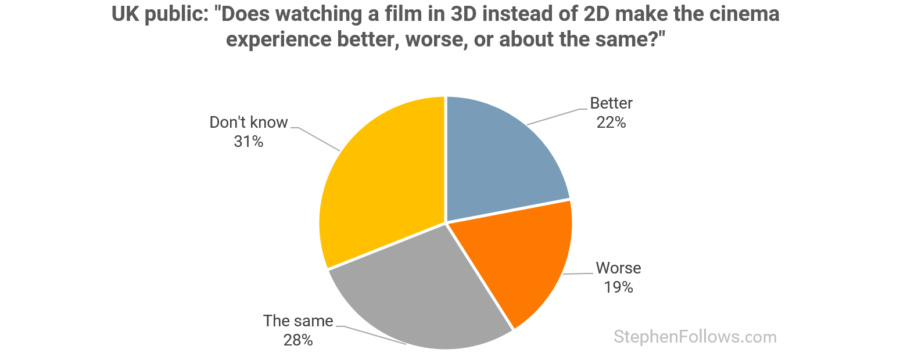
That same survey revealed that only 17% of people disagreed with the statement that 3D movies were "a phase that will pass". 41% of people called 3D movies a gimmick and only 19% felt that the format "improved the quality of a film".
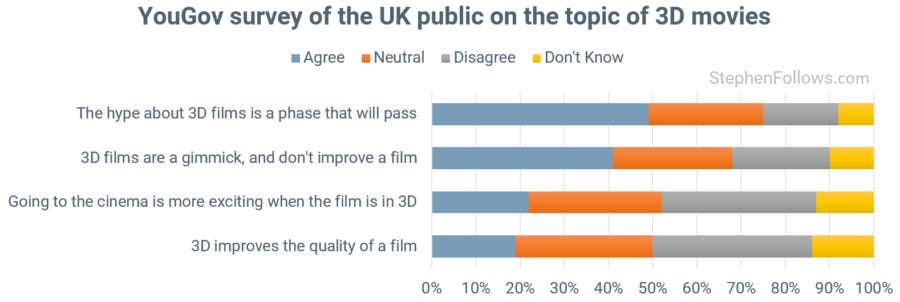
Finally, the survey revealed that part of the barrier to 3D movies are the glasses. 52% of respondents said that they would be more likely to watch a 3D movie in the cinema if they didn't need to wear 3D glasses. 40% said removing glasses from the equation wouldn't affect their decision, 4% didn't know and 4% said it would make them less likely to go to the cinema.
Another reason why 3D movies may not have yet caught the public's imagination is the side-effects felt by some. A 2013 research paper published in PLOS One entitled "Are There Side Effects to Watching 3D Movies" concluded that "Seeing 3D movies can increase... symptoms of nausea, oculomotor and disorientation". This is because human brains have two methods of determining depth (receiving different images in each eye, and the effect of moving one's head) and current 3D technology can only fool us on the first count.
How are 3D movies performing?
So it seems that the public are not exactly fired up by the prospect of a movie being presented in 3D. Now that 3D movies have been around for a while, are we becoming keener to watch them or has the novelty worn off?
The data suggest the latter. If we look at the percentage of the total box office gross earned by 3D versions of movies, we can see that 2010 was a high point. Since then, both the UK and North American markets have experienced a near-consistent decline in the 3D share. In 2010, 22% of US revenues went to 3D movies whereas by 2016 it was just a third of that, at 7%. Similarly, the UK 3D cinema market share fell from 21% in 2010 to 14% in 2016.
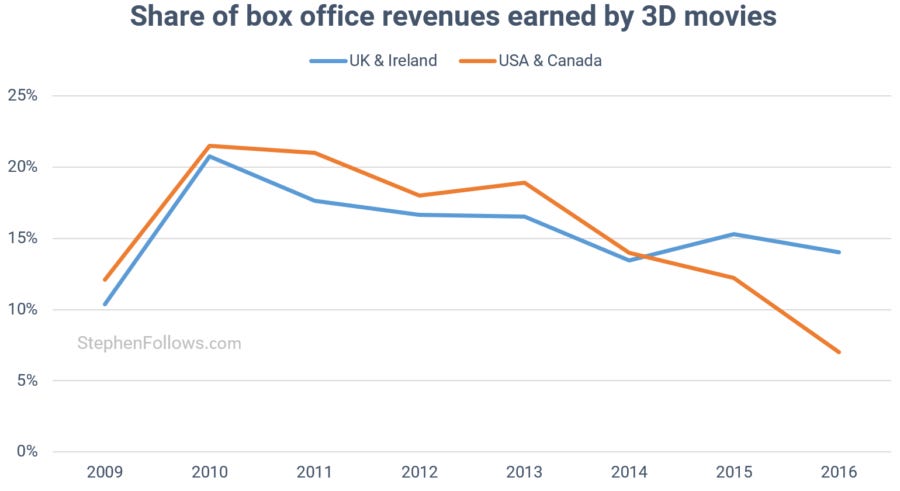
So it does seem that we are in the middle of a 3D decline.
How will the film industry respond to this 3D decline?
Hollywood studios and cinemas love 3D movies. Not because they think it improves their movies, but because it's almost impossible to pirate the 3D cinema experience and because they can charge higher prices for cinema tickets.
In 2014 I ran a survey of over 1,200 film industry professionals and I asked them whether they felt that a movie is more enjoyable in 3D when compared with 2D. Overall, only 5% of respondents prefered 3D, and almost all of these people worked in either marketing or in professions such as film accountancy or law.
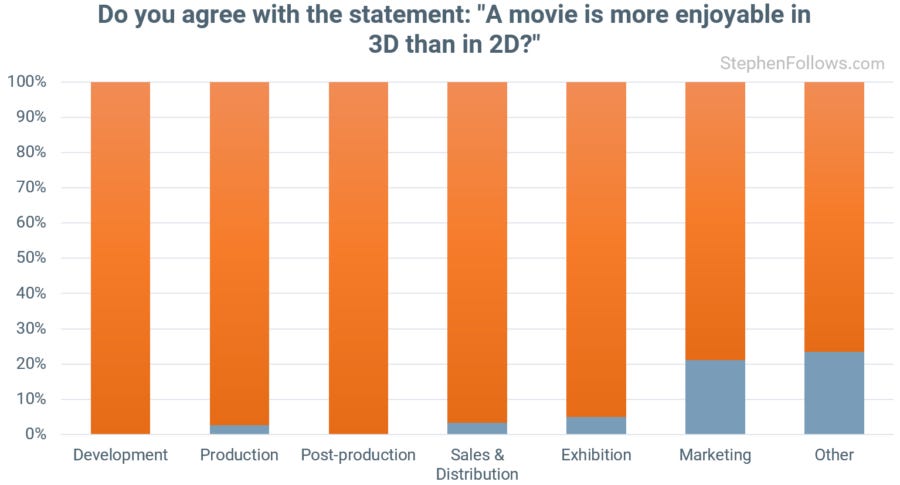
So the move to 3D has not been one of artistic vision or based on a deeply-held belief that 3D movies are better. Rather, it has been pure pragmatism when focusing on the bottom line. Therefore, will this decline in 3D revenues mean that we start to see fewer 3D movie releases?
Well, maybe. But in order for the studios to stop producing 3D movies, there would have to be a 3D decline worldwide. Currently, movies in either 3D or IMAX formats have a much easier time getting released in the second-largest movie market - China. (More on that at stephenfollows.com/film-business-in-china).
In 2007, the US and Canada had between them 77% of the world's 3D screens (994 of a worldwide total of 1,297). By 2016, there were 17 times as many 3D screens in North America (16,745) but the global total had increased by over 67 times (to 87,176).
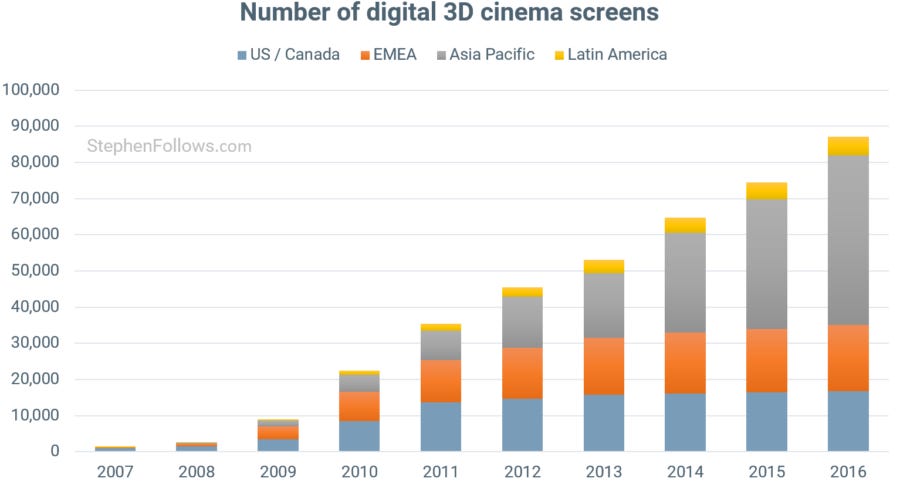
This means that a decline in US 3D revenues is more than offset by the growth in other parts of the world.
3D TV RIP
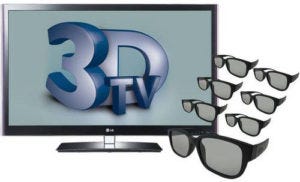
Before we leave this topic it's worth us briefly visiting another frontier of the third-dimensional front - 3D home cinema. It seems as though the journey the 3D television market has taken mirrors the 3D cinema journey, albeit at a much quicker pace.
First, there was the flurry of excitement. In a 2010 survey by Roxio, 84% of US consumers said they were interested in viewing Hollywood 3D movies at home. 80% also said they believe they will film or photograph family events in 3D within five years.
Initial examples proved popular with early-adopters. Panasonic brought out the world's first 3D home entertainment system in March 2010, priced at $2,900, plus $150 for each set of 3D glasses. Despite the high price tag, these models sold out in their first week on sale.
The hype built. Predictions were made that by 2014 over a third of televisions sold would be 3D.
The reality was underwhelming. A 2012 NPD survey revealed that just 14% of people considering buying a new television regarded 3D functionality as a "must have" feature. Four out of five respondents blamed the need to wear glasses as their main reason for not wanting a 3D television.
Confidence slipped. Articles started to appear questioning the inevitability of a 3D TV boom, including "The 3D Hype Bubble Is Now Completely Busted" (Time, July 2012), "3D TV Is Dead" (The Atlantic, January 2014) and "Is 3D TV Dead or Just Dormant?" (Motley Fool, January 2014). And it wasn't just the media questioning the hype. A senior manager within Panasonic was quoted in 2013 as saying that while his company had "spent a lot of money investing in 3D" the investment "hadn't really worked".
In 2010, a YouGov survey showed that two-thirds of Britons believed that most TV in the future would be watched in 3D. By 2016 the majority had swung against 3D, with more Britons believing it wasn't the future than those who did.
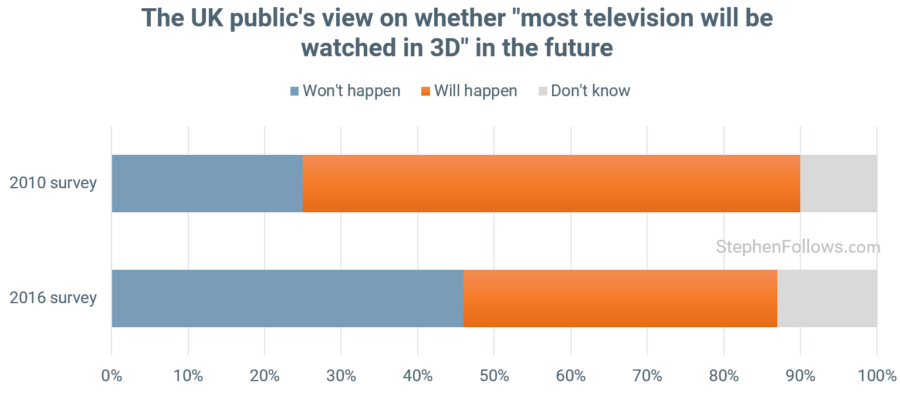
Sales declined. In 2012, 3D television accounted for 23% of the amount spent on television in the US. By 2015 that had fallen to 16% and in 2016 it was at just 8%.
The industry turned away from 3D. At the start of 2017, the last two major manufacturers of 3D televisions - LG and Sony - announced that they would not be creating any new models. LG's director of new product development said: "Purchase process research showed it's not a top buying consideration, and anecdotal information indicated that actual usage was not high".
An intriguing footnote to this topic is that earlier this year, the 3D Blu-ray edition of Rogue One sold out quickly in the US. It's unclear if this was purely due to Disney understocking retailers or if it shows that 3D could have a future within the dedicated, tech-savvy fan base of certain movies.
What is the future for 3D movies?
Interestingly, the current decline in 3D revenues comes at a time when arguably Hollywood has finally figured out how to make 3D movies well. In the early days of the current 3D revival, there were only a small number of films which were shining examples of how spectacular 3D can be (Avatar and Hugo being the highest profile movies). Aside from these outliers, most early 3D movies were converted to 3D rather poorly (such as Thor, The Last Airbender and Clash of the Titans). They suffered from feeling like a pop-up book where there were just a few flat plains stacked on top of each other.
However, time has passed and the post-production process for converting movies to 3D has got a whole lot more advanced. This has meant that filmmakers can shoot in 2D, convert to 3D in post-production and not be concerned about achieving poor results. A whole industry has formed around 3D conversion and the recent 3D re-versioning of Terminator 2 took a team of more than 1,400 artists and technicians over a year to complete.

In 2008, 10 out of the 19 3D movies released were shot in native 3D (using cumbersome stereo rigs and two cameras). However, none of the 23 live-action 3D movies released in the first half of 2017 were shot in 3D - all were converted during post-production.
Therefore, one could argue that the public's opinion of 3D movies has been negatively affected by too many poor conversions released in the early days. Maybe better quality products coming down the pipeline will reverse the decline. Only time will tell.
Notes
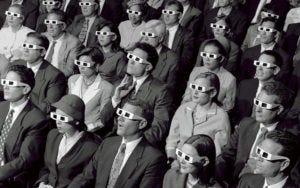
The data for today's piece came from a variety of sources. UK box office data came from the Film Distributors Association and the BFI. US box office data came from the MPAA and comScore. All figures for the UK box office refer to the UK and the Republic of Ireland, as the industry regards these two markets as a single territory. Similarly, the US box office includes the United States and Canada. The number of cinema screens came via IHS and the MPAA.
Determining the exact number of 3D releases for my first chart was tricky. Early "movies" were often short films, rather than features, and later 3D movies were sometimes designed for theme park rides rather than traditional cinemas. I included the chart because it's useful for context but I can't be as sure as I normally am of every number you see. Much of the data comes from Sony, IMDb and Wikipedia.
If you want to read more on the topic then I recommend an academic paper which studied 3D movies between 2004 and 2011 entitled "Does 3D Make Sense for Hollywood? The Economic Implications of Adding a Third Dimension to Hedonic Media Products".
Epilogue
Right now it's difficult to know what the future holds for 3D. The format has been both written off and overhyped consistently since its inception.
The boom and bust of 3D television may contain a warning to cinemas that consumers are largely ambivalent about the third dimension and vote with their feet when faced with paying much more for it.
Or maybe 3D is still too dimensionally deficient. The rise of 4D experiences could be the next big thing...


